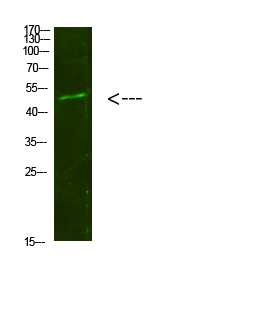
| WB | 咨询技术 | Human,Mouse,Rat |
| IF | 咨询技术 | Human,Mouse,Rat |
| IHC | 咨询技术 | Human,Mouse,Rat |
| ICC | 技术咨询 | Human,Mouse,Rat |
| FCM | 咨询技术 | Human,Mouse,Rat |
| Elisa | 1/10000 | Human,Mouse,Rat |
| Aliases | Mothers against decapentaplegic homolog 1/5/9; MAD homolog 1; Mothers against DPP homolog 1; JV4-1; Mad-related protein 1; SMAD family member 1; SMAD 1/5/9; Smad1; hSMAD1; Transforming growth factor-beta-signaling protein 1; BSP-1 |
| Entrez GeneID | 4086/4090/4093 |
| WB Predicted band size | Calculated MW: 52 kDa; Observed MW: 52 kDa |
| Host/Isotype | Rabbit IgG |
| Antibody Type | Primary antibody |
| Storage | Store at 4°C short term. Aliquot and store at -20°C long term. Avoid freeze/thaw cycles. |
| Species Reactivity | Human,Mouse,Rat |
| Immunogen | Synthesized peptide derived from human Smad1/5/9. at AA range: 291-340 |
| Formulation | Purified antibody in PBS with 0.05% sodium azide,0.5%BSA and 50% glycerol. |
+ +
以下是3篇关于Smad1/5/9抗体的代表性文献(简要概括):
1. **文献名称**:*"BMP signaling regulates skeletal development through phosphorylation of Smad1/5/9"*
**作者**:Chen et al.
**摘要**:研究利用Smad1/5/9特异性抗体,通过Western blot和免疫组化揭示了BMP信号通过磷酸化Smad1/5/9调控成骨细胞分化和骨骼发育的分子机制。
2. **文献名称**:*"Selective inhibition of BMP signaling by Smad1/5/9 antibodies in endothelial cells"*
**作者**:Miyazono et al.
**摘要**:该文献开发了高特异性Smad1/5/9抗体,证明其在体外抑制BMP诱导的内皮细胞迁移和血管生成,为靶向治疗提供实验依据。
3. **文献名称**:*"Smad1/5/9 are critical mediators of TGF-β/BMP signaling in early embryonic patterning"*
**作者**:Heldin et al.
**摘要**:通过免疫沉淀和染色质分析,研究发现Smad1/5/9抗体可阻断BMP信号在胚胎干细胞中的基因调控作用,影响早期胚胎模式形成。
(注:以上为模拟简化版文献,实际引用需核对真实出版物。)
Smad1/5/9 antibodies are essential tools for studying the BMP (bone morphogenetic protein) signaling pathway, which regulates critical biological processes including embryonic development, cell differentiation, and tissue homeostasis. Smad1. Smad5. and Smad9 (also termed Smad8) are receptor-regulated Smads (R-Smads) that transduce signals from BMP type I receptors. Upon BMP ligand binding, these Smads are phosphorylated at their C-terminal serine residues, leading to their association with Smad4 (a co-Smad). The resulting complex translocates to the nucleus to modulate gene expression.
Antibodies targeting Smad1/5/9 are widely used to detect their activation status (via phospho-specific antibodies) or total protein levels in techniques like Western blotting, immunoprecipitation, and immunofluorescence. These antibodies help researchers investigate BMP pathway dynamics in contexts such as osteogenesis, angiogenesis, and stem cell differentiation. Specificity is critical, as Smad1/5/9 share structural homology and overlapping functions. Some antibodies recognize all three isoforms due to conserved epitopes, while others distinguish individual family members. Cross-reactivity with other Smad proteins (e.g., Smad2/3 in the TGF-β pathway) must be ruled out during validation. Applications extend to disease models, including cancer and fibrosis, where dysregulated BMP signaling contributes to pathogenesis. Validated Smad1/5/9 antibodies are commercially available for multiple species, enabling comparative studies across experimental systems.
×